Ocean acidification changes the interspecific competition of Sargassum fusiforme and Ulva lactuca by regulating carbon and nitrogen metabolism
IF 4.5
1区 生物学
Q1 MARINE & FRESHWATER BIOLOGY
引用次数: 0
Abstract
Due to different response mechanisms of cultivated Sargassum fusiforme and its main epiphyte Ulva lactuca to ocean acidification caused by increased CO2 concentrations, the effects of U. lactuca on its host may be different at elevated CO2 concentrations. In this study, the effects of U. lactuca on the photosynthetic carbon assimilation process of S. fusiforme were studied under the condition of elevated CO2 concentration. The results showed that co-culture with U. lactuca significantly inhibited the growth, photosynthesis and nitrogen metabolism of S. fusiforme, up-regulated the expression of its carbon assimilation-related genes such as antenna protein, phosphoglycerate kinase (PGK), ribulose-1,5-diphosphate carboxylase/oxygenase (RuBisCo), and down-regulated the expression of genes associated with growth and nitrogen metabolism. Under monoculture conditions, the growth and photosynthesis of S. fusiforme were significantly enhanced by elevated CO2, and the expressions of photosynthetic carbon assimilation and antenna protein-related genes were up-regulated, reflecting the promotion of S. fusiforme photosynthesis. However, the enzyme activity and gene expression of nitrogen metabolism were inhibited. Under co-culture condition, the increase of CO2 concentration also promoted the photosynthesis and growth of S. fusiforme, and up-regulated the expression of genes related to photosystem Ⅱ (PSⅡ) central proteins (including D1 and D2 proteins). The results of this study showed that U. lactuca inhibited the photosynthesis, growth and nitrogen metabolism of S. fusiforme, while ocean acidification promoted the photosynthesis of S. fusiforme by increasing activity of PSII, changing the carbon and nitrogen metabolism strategy, thus greatly alleviating the interspecific stress from its epiphyte U. lactuca. These results had important implications for exploring the ecological significance of seaweed farming and carbon sequestration efficiency in the context of future climate change.
海洋酸化通过调节碳氮代谢改变马尾藻和乳酸藻的种间竞争
由于人工养殖马尾藻及其主要附生植物乳酸藻对CO2浓度升高引起的海洋酸化的响应机制不同,乳酸藻对宿主的影响可能在CO2浓度升高时有所不同。本研究在CO2浓度升高的条件下,研究了乳酸菌对纺锤状梭菌光合碳同化过程的影响。结果表明,与乳酸菌共培养显著抑制了棘豆的生长、光合作用和氮代谢,上调了棘豆天线蛋白、磷酸甘油酸激酶(PGK)、核酮糖-1,5-二磷酸羧化酶/加氧酶(RuBisCo)等碳同化相关基因的表达,下调了棘豆生长和氮代谢相关基因的表达。在单作条件下,CO2浓度升高显著促进了梭形镰刀菌的生长和光合作用,光合碳同化和天线蛋白相关基因表达上调,反映了梭形镰刀菌光合作用的促进。但氮代谢酶活性和基因表达均受到抑制。在共培养条件下,CO2浓度的增加也促进了梭形镰刀菌的光合作用和生长,并上调了光系统Ⅱ(PSⅡ)中心蛋白相关基因(包括D1和D2蛋白)的表达。本研究结果表明,乳酸菌抑制了梭梭菌的光合作用、生长和氮代谢,而海洋酸化通过增加PSII活性,改变碳氮代谢策略,促进了梭梭菌的光合作用,从而大大减轻了其附生真菌乳酸菌的种间胁迫。这些结果对于探索未来气候变化背景下海藻养殖的生态意义和固碳效率具有重要意义。
本文章由计算机程序翻译,如有差异,请以英文原文为准。
求助全文
约1分钟内获得全文
求助全文
来源期刊

Harmful Algae
生物-海洋与淡水生物学
CiteScore
12.50
自引率
15.20%
发文量
122
审稿时长
7.5 months
期刊介绍:
This journal provides a forum to promote knowledge of harmful microalgae and macroalgae, including cyanobacteria, as well as monitoring, management and control of these organisms.
 求助内容:
求助内容: 应助结果提醒方式:
应助结果提醒方式:


